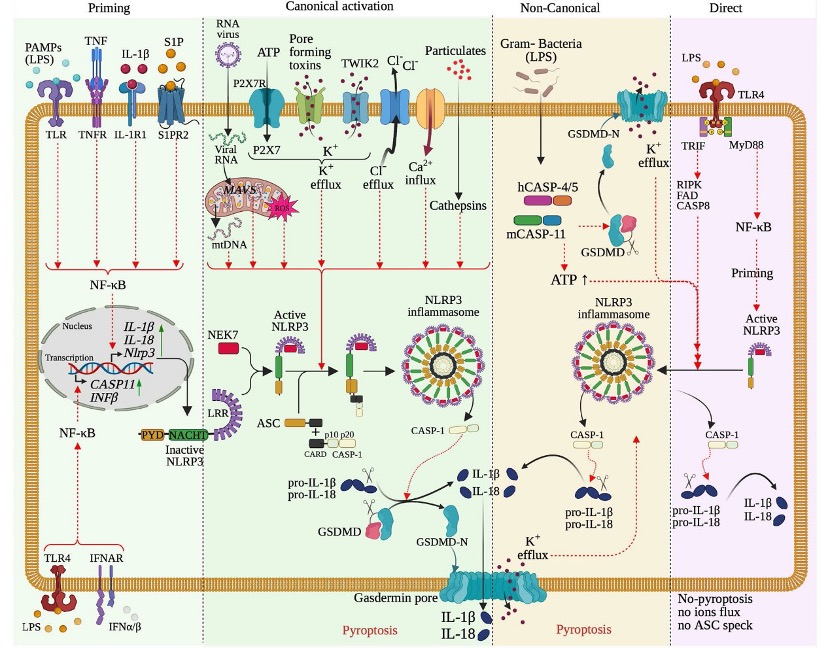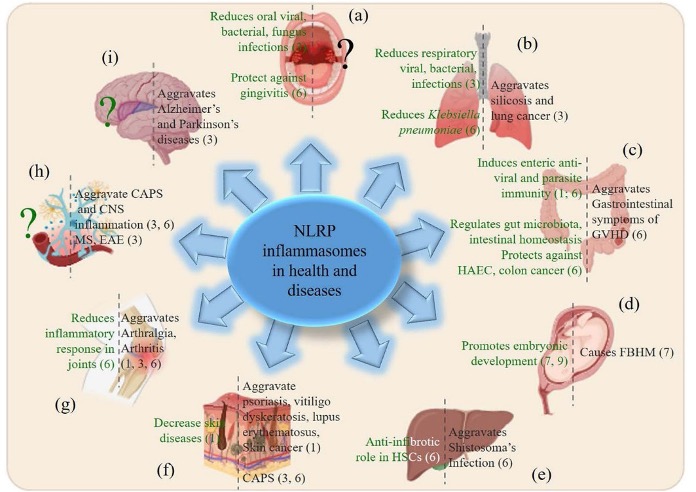Molecular Biomedicine Review | Professor Tengchuan Jin 's Team from USTC Systematically Summarizes the Latest Research Progress on NLRP Inflammasomes in Health and Disease
On April 22, 2024, Professor Tengchuan Jin's team from the University of Science and Technology of China (USTC) published a review article titled "NLRP inflammasomes in health and disease" in the journal Molecular Biomedicine. This review systematically summarizes the structural and assembly features, signaling transduction, and molecular activation mechanisms of NLRP inflammasomes (Fig. 1), as well as important findings on the involvement of NLRP inflammasome dysregulation in various human autoinflammatory, autoimmune, and neurodegenerative diseases (Fig. 2).

Figure 1. Mechanism of NLRP inflammasome activation: case of NLRP 3 inflammasome.
NLRP inflammasomes are a group of cytosolic multiprotein oligomer pattern recognition receptors (PRRs) involved in the recognition of pathogen-associated molecular patterns (PAMPs) and danger-associated molecular patterns (DAMPs) produced by infected cells. They regulate innate immunity by triggering a protective inflammatory response. However, despite their protective role, dysregulated NLPR inflammasome activation mainly associated with infections or gain-of-function mutations in NLRP sensor proteins are involved in occurrence and enhancement of non-communicating autoimmune, auto-inflammatory, and neurodegenerative diseases. In the last few years, significant advances have been achieved in the understanding of the NLRP inflammasome physiological functions and their molecular mechanisms of activation, as well as therapeutics that target NLRP inflammasome activity in inflammatory diseases. Here, we provide the latest research progress on NLRP inflammasomes, including NLRP1, CARD8, NLRP3, NLRP6, NLRP7, NLRP2, NLRP9, NLRP10, and NLRP12 regarding their structural and assembling features, signaling transduction and molecular activation mechanisms. Importantly, we highlight the mechanisms associated with NLRP inflammasome dysregulation involved in numerous human auto-inflammatory, autoimmune, and neurodegenerative diseases. Overall, we summarize the latest discoveries in NLRP biology, their forming inflammasomes, and their role in health and diseases, and provide therapeutic strategies and perspectives for future studies about NLRP inflammasomes.

Figure 2. Roles of NLRP in health and diseases in different organs and tissues.
Schematic Schematic representation of the different functions of NLRP in (a) oral cavity, (b) lungs, (c) digestive system, (d) pregnancy and fetus, (e) liver, (f) skin, (g) joints, (h) peripheral and central nervous system, (i) brain. Functions shown in green represent the NLRP inflammasome-dependent protective response (or NLRP beneficial roles in health) and functions shown in black represent the NLRP inflammasomes-associated diseases (or NLRP detrimental roles in diseases). Numbers in brackets indicate the different NLRPs associated. “?” indicates unknown roles of NLRP inflammasomes.
Significance of the Paper:
This review summarizes the latest discoveries on the roles of NLRP inflammasomes in health and disease and provides therapeutic strategies and perspectives for future research on NLRP inflammasomes.
Authors and Support:
Professor Tengchuan Jin, Professor Jianbin Ruan, and Researcher Ying Zhou are the corresponding authors of this paper. The first authors are Doctor Zhihao Xu and Doctor Arnaud John Kombe Kombe from the Division of Life Sciences and Medicine at the University of Science and Technology of China.
Funding:
This research was supported by the Strategic Priority Research Program of the Chinese Academy of Sciences and the National Natural Science Foundation of China.
Link to the Paper:
https://link.springer.com/article/10.1186/s43556-024-00179-x

